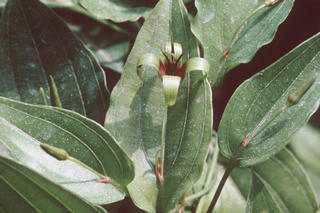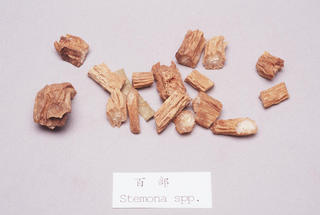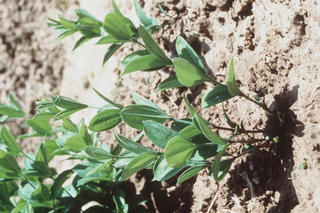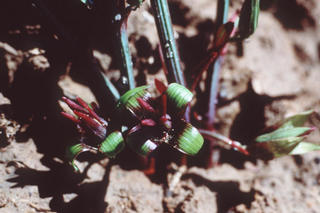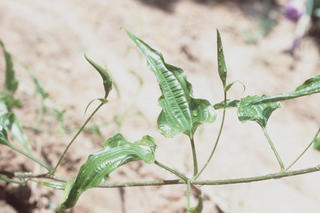Stemona sessilifolia
Contents
Nomenclature
Other Names:
Historical Use of Stemona sessilifolia
Stemona sessilifolia in Traditional Chinese Medicine
Background
Zhibaibu ÖË°Ù²¿
Chinese Name (pinyin): Baibu
Chinese Name :
Common Name :Stemona Root
Specific Name : Radix stemonae
Scientific Name:
Collection : The drug is collected in spring and autumn, removed from rootlet, wash clean, treated with boiling water for a moment or steamed until the center of the cut surface is devoid of a white core and dried in the sun.
Description : Root of Stemona japonica: Two ends slightly thin, externally mostly with irregular longitudinal folds and transverse wrinkles.
Identification : 1. Transverse sectionRoot of Stemona sessilifolia: Velamen of 3 - 4 layers of cells, walls suberized and lignified with dense and fine striations. Cortex relatively broad. In stele phloem bundles and xylem bundles 19 --27 respectively. Arranged alternately with a few non-lignified fibres in the inner side of the phloem bundles. Xylem bundles with 2 - 5 vessels, xylem fibres and tracheids, vessels subpolygonal, 48 µm in diameter, radially, occasionally penetrating into the pith. A few small fibres scattered in pith.Root of Stemona japonica: Velamen 3 - 6 layers of cells. Phloem fibres lignified. Vessels up to 184 µm in diameter, radially, usually penetrating into the pith, arranged in 2 - 3 whorls.Root of Stemona tuberosa: Velamen of 3 layers of cells, walls without fine striations, The inner walls of the inner layers heavily thickened. Fibres scattered in the outer part of cortex, subsquare with slightly lignified walls. In stele phloem bundles 36 - 40. Vessels in the xylem bundles rounded polygonal up to 107 µm in diameter. The inner sides of the xylem fibres and slightly lignified parenchymatous cells into a ring.3.Heat under reflux 5 g of the powder with 50 ml of 70% ethanol for 1 hour, filter and evaporate the filtrate to removed the ethanol. To the residue and concentrated ammonia TS, adjust to pH 10 - 11. Extract with 5 ml of chloroform solution to dryness. Dissolve the residue in 5 ml of 1% hydrochloric acid solution and filter. Separate the filtrate into two portions. To 1 portion add 1 drop of potassium oidobismuthate TS, an oranged red precipitate is produced, to another portion add 1 drop of silicotungstic acid TS, a milky white precipitate is producedExtractives: Carry out the hot extraction method described under the determination of water soluble extractives (Appendix X A), not lees than 50.0%
Processing : Radix Stemonae: Eliminate foreign matter, wash clean, soften thoroughly, cut into thick slices and dry. Occurring in irregular thick slices or irregular slat shaped oblique slices. Externally greyish white or brownish yellow, deep wrinkled longitudinally, cut surface greyish white, pale yellowish brown or yellowish white, horny bark relatively thick, stele compressed. Texture flexible and soft. Odour slight, taste sweet and bitter.Radix Stemona (stir fried with honey): Stir fry the slices as described under the method for stir frying with honey (Appendix ll D) until it is not sticky in the fingers, using 12.5 kg of refined honey for 100 kg of Radix Stemonae.The form similar to the slice of Radix Stemonae, but externally brownish yellow or brown with less burnt specks, slightly sticky, taste sweet.
Action : To moisten the lung and relieve cough, and to kill insects and worms. Radix Stemonar (Stir-fried with honey): To moisten the lung and relieve cough.
Indication : acute and chronic cough, cough in phthisis, whooping cough
external use: pediculosis capitis, pediculosis corporis, oxyruiasis, pudendal itching
stir-fried with honey: cough in phthisis
Precautions :
Dosage : 3 to 9 g; for external use, appropriate quantity to be decocted with water or infused in wine.
Storage : Preserve in a ventilated dry place, protected from moisture.
Synonymns for Stemona sessilifolia
Patent Medicines and Medicines with Multiple Ingredients that include Stemona sessilifolia
Pharmaceutical Information
Chemical Constituents
Evidence or the Use of Stemona sessilifolia in the Treatment of Epilepesy
Basic Science
Animal Studies
Cohort, Case-Control and Non-Randomized Trials
Randomized Controlled Trials
Meta-Analysis
1st Five Results: pubmed search
Wanru Jiang, Bo Liu, Gang Chen, Lichao Wei, Di Zhou, Yingjie Wang, Yuqing Gui, Chenhui Wang, Yehan Yang, Lu Sun, Ning Li
Characteristic alkaloids from Stemona sessilifolia with lung protective effects.
Bioorg Chem: 2024, 143;107033
[PubMed:38104498]
[WorldCat.org]
[DOI]
(I p)
Yahui Dong, Yang Liu, Jie Tang, Jiahui Du, Xuzhen Zhuang, Song Tan, Ye Yang, Dengke Yin
Zhisou powder displays therapeutic effect on chronic bronchitis through inhibiting PI3K/Akt/HIF-1α/VEGFA signaling pathway and reprograming metabolic pathway of arachidonic acid.
J Ethnopharmacol: 2024, 319(Pt 1);117110
[PubMed:37673198]
[WorldCat.org]
[DOI]
(I p)
Yang Liu, Amei Tang, Ming Liu, Changjun Xu, Feng Cao, Changfu Yang
Tuberostemonine may enhance the function of the SLC7A11/glutamate antiporter to restrain the ferroptosis to alleviate pulmonary fibrosis.
J Ethnopharmacol: 2024, 318(Pt B);116983
[PubMed:37532076]
[WorldCat.org]
[DOI]
(I p)
Donglinag Li, Shunli Lu, Yichen Jian, Shuqi Cheng, Qianming Zhao, Huizhen Yuan, Nanhao Wang, Yufeng Liu, Sumei Zhang, Longxian Zhang, Rongjun Wang, Fuchun Jian
Acaricidal and repellent activities of ethanol extracts of nine chinese medicinal herbs against Rhipicephalus microplus (Acari: Ixodidae).
Exp Appl Acarol: 2023, 91(1);69-87
[PubMed:37522955]
[WorldCat.org]
[DOI]
(I p)
Ran Wei, Qiang Li
##Title##
Genes (Basel): 2022, 13(8);
[PubMed:36011272]
[WorldCat.org]
[DOI]
(I e)
